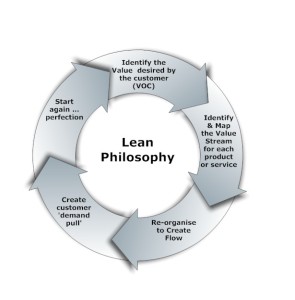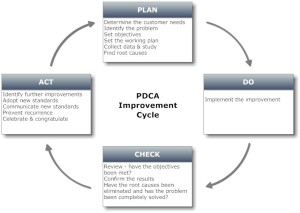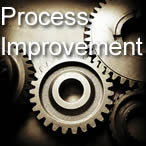Process Improvement – the Essence of Lean
Lean is a philosophy to continuously identify and eliminate waste within an organisation, where waste is defined as any activity that does not, from the customer’s perspective, add value. Fundamentally the Lean Philosophy is about continuous process improvement to create a business system that optimally responds to customer demand.As is shown in figure 1 below, Lean can be depicted as a repetitive 5-stage process that begins with the identification of the value desired by the customers, where a ‘customer’ in this instance is not limited to the external customers that actually pay for a product or service, but includes any service recipient within the business itself.

Figure 1. Lean is a continuous 5-stage process
Having listened to the customer to understand the true value of the product or service from the customer’s point of view, one can then progress further down the Lean path and identify those internal processes that, again from the customer’s perspective, contribute, or add value to the product or service, i.e. identify the value stream for each product or service group. In order to improve any process, one must first gain a thorough understanding of its current state and the simplest way to achieve this is to draw or map the process to create ‘process map’. As shown in figure 2, this is the sequence of all current processes, both value adding and non-value adding from raw material to product launch or from initial customer contact to service completion.

Figure 2. Basic Process Map
By adding information flows and other relevant data including lead times, batch sizes, processing times and number of operators to the process map, one can create a true Value Stream Map that can be analysed to identify problem areas, eliminate waste and plan for an improved future state. The classic Deming PDCA improvement cycle is often used as powerful tool in conjunction with process and value stream maps, to create flow (the third stage of Lean), and ensure that improvements are carried out in accordance with a well organised and defined methodology.

Figure 3. Deming’s PDCA Improvement Cycle
In Deming’s cycle, the Plan is not just about planning, but also includes communicating and gaining consensus. Far too often companies neglect this phase and fail to properly identify constraints and/or ‘root causes’ of problems. It has often been stated that Japanese companies take much longer to plan, but then implement improvements faster and more smoothly than those companies that don’t. Do is the easy stage where the actual implementation is carried out, and this must be followed by the all important Check phase. The Check is actually a learning phase where the prevailing question should be “is the change sustainable and did it work as we predicted, and if not, what can we learn for next time?” The final phase is the Act, where the emphasis is to standardise and communicate the improvement, prevent recurrence and to prepare for the next round of the cycle. The PDCA sounds simple but it is often glossed over as many organisations concentrate on the ‘do’ and neglect the P-C-A, or alternatively adopt Murphy’s corollary to Deming’s PDCA cycle, i.e. “Please Don’t Change Anything”.In addition to process and value stream maps, various other analysis tools can be used in the PDCA cycle, for example, spaghetti diagrams, fish-bone diagrams, root cause analysis, activity sampling and risk analysis. Further, the PDCA cycle may be varied to encompass the 6 Sigma methodology known as DMAIC (Define, Measure, Analyse, Improve, Control), but the fundamental aspect of the improvement cycle remains unchanged.Process improvement is the essence of Lean, for without improvement, any organisation will fail. For a sustainable business, process improvement must reach all levels and involve all value streams within the business, both internally and along its supply chain.For further information contact:
Mike Karle
Mobile: 0410 780-627
mike.karle@informgroup.com.au







